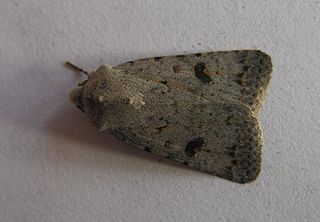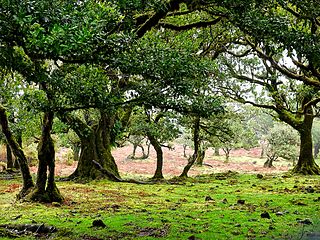
Madeira, officially the Autonomous Region of Madeira, is one of two autonomous regions of Portugal, the other being the Azores. It is an archipelago situated in the North Atlantic Ocean, in a region known as Macaronesia, just under 400 kilometres (250 mi) to the north of the Canary Islands and 520 kilometres (320 mi) west of the Kingdom of Morocco. Madeira is geologically located on the African Tectonic Plate, although it is culturally, politically and ethnically associated with Europe, with its population predominantly descended from original Portuguese settlers. Its population was 251,060 in 2021. The capital of Madeira is Funchal, which is located on the main island's south coast.

The Fea's petrel is a small seabird in the gadfly petrel genus, Pterodroma. It was previously considered to be a subspecies of the soft-plumaged petrel, but they are actually not closely related at all. However, P. feae is very closely related to Zino's petrel and Desertas petrel, two other species recently split from P. mollis. The gadfly petrels are named for their speedy weaving flight, as if evading horseflies. The flight action is also reflected in the genus name Pterodroma, from Ancient Greek pteron, "wing" and dromos, " runner". This species is named after the Italian zoologist Leonardo Fea (1852-1903).

Zino's petrel or the freira, is a species of small seabird in the gadfly petrel genus, endemic to the island of Madeira. This long-winged petrel has a grey back and wings, with a dark "W" marking across the wings, and a grey upper tail. The undersides of the wings are blackish apart from a triangle of white at the front edge near the body, and the belly is white with grey flanks. It is very similar in appearance to the slightly larger Fea's petrel, and separating these two Macaronesian species at sea is very challenging. It was formerly considered to be a subspecies of the soft-plumaged petrel, P. mollis, but they are not closely related, and Zino's was raised to the status of a species because of differences in morphology, calls, breeding behaviour and mitochondrial DNA. It is Europe's most endangered seabird, with breeding areas restricted to a few ledges high in the central mountains of Madeira.

The Savage Islands or Selvagens Islands are a small Portuguese archipelago in the North Atlantic Ocean, 280 kilometres (175 mi) south of Madeira, and 165 kilometres (105 mi) north of the Canary Islands. The archipelago includes two major islands, Selvagem Grande and Selvagem Pequena, each surrounded by a cluster of islets and reefs, with the total area of 2.73 km2 (1.05 sq mi). The archipelago is administered as part of the Portuguese municipality of Funchal, belongs to the Madeiran civil parish of Sé, and is the southernmost point of Portugal.

The superfamily Ichneumonoidea contains one extinct and three extant families, including the two largest families within Hymenoptera: Ichneumonidae and Braconidae. The group is thought to contain as many as 100,000 species, many of which have not yet been described. Like other parasitoid wasps, they were long placed in the "Parasitica", variously considered as an infraorder or an unranked clade, now known to be paraphyletic.

The Madeira firecrest, Madeira kinglet, or Madeiracrest is a very small passerine bird endemic to the island of Madeira. It is a member of the kinglet family. Before it was recognised as a separate species in 2003, it was classified as a subspecies of the common firecrest. It differs in appearance and vocalisations from its relative, and genetic analysis has confirmed it as a different species. The Madeiran bird has green upperparts, whitish underparts and two white wingbars, and a distinctive head pattern with a black eye stripe, short white supercilium, and a crest that is mainly orange in the male and yellow in the female.

Phengaris alcon, the Alcon blue or Alcon large blue, is a butterfly of the family Lycaenidae and is found in Europe and across the Palearctic to Siberia and Mongolia.

Phengaris rebeli, common name mountain Alcon blue, is a species of butterfly in the family Lycaenidae. It was first found and described in Styria, Austria, on Mount Hochschwab around 1700. Although it was initially classified as a subspecies of P. alcon, a European researcher, Lucien A. Berger, designated it as a separate species in 1946. Genetic similarities between P. rebeli and P. alcon have led many researchers to argue that the two are the same species and differences are due to intraspecific variation.

Rhamnus glandulosa is a species of plant in the family Rhamnaceae. It is endemic to Madeira and the Canary Islands.

John Henry Leech was an English entomologist who specialised in Lepidoptera and Coleoptera.

Paradrina rebeli is a moth of the family Noctuidae. The species was first described by Otto Staudinger in 1901. It is endemic to the Canary Islands. Some authors consider the genus Paradrina to be a subgenus of Caradrina, hence the species is also known as Caradrina rebeli or Caradrina (Paradrina) rebeli.

Blastobasis adustella is a species of moth of the family Blastobasidae. It is endemic to Australian region, but was introduced in western Europe and is now reported from The Netherlands, Great Britain, Ireland, Madeira and the Azores

Clethra arborea, commonly known as the lily-of-the-valley-tree, is a flowering plant in the genus Clethra. It is found in Macaronesia where it is native to Madeira, extinct in the Canary Islands, and considered an introduced species in the Azores. In Madeira its natural habitat is laurisilva forest.
Neomariania partinicensis is a species of moth of the Stathmopodidae family. It is found in the Mediterranean area.
Parahyponomeuta bakeri is a moth of the family Yponomeutidae. It is found on Madeira.
Blastobasis rebeli, the marsh dowd moth, is a moth in the family Blastobasidae found on Madeira. It was first recorded from Hampshire, Great Britain in 1998 and there have been subsequent records from the same area and nearby, as well as in West Sussex.

Luffia rebeli is a moth of the Psychidae family. It is found on the Canary Islands.
Scrobipalpa rebeli is a moth of the family Gelechiidae. It is found in Austria, Italy, Ukraine and the Krasnoyarsk region in southern Siberia. It is also present in China (Shaanxi) and Japan.

The Madeira evergreen forests is a laurissilva ecoregion of southwestern Europe. It covers the archipelago of Madeira and some nearby islands in the Atlantic Ocean. Laurel forest, known as laurissilva, once covered the islands. Over centuries the laurel forests were mostly cleared. Madeira's remaining forests are now protected.













